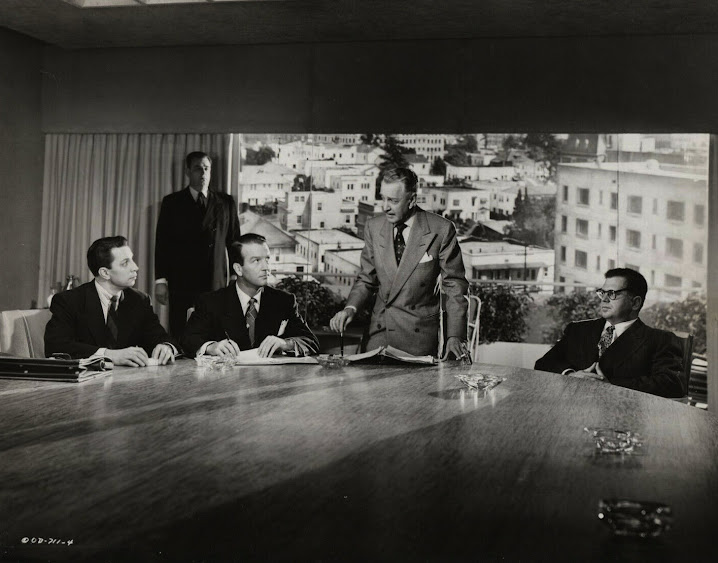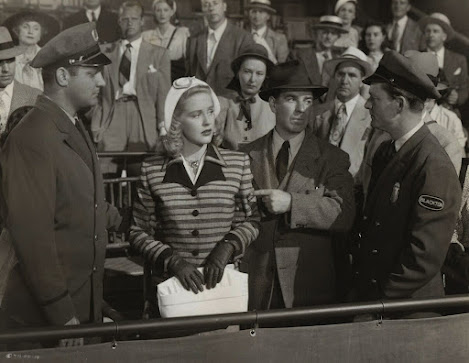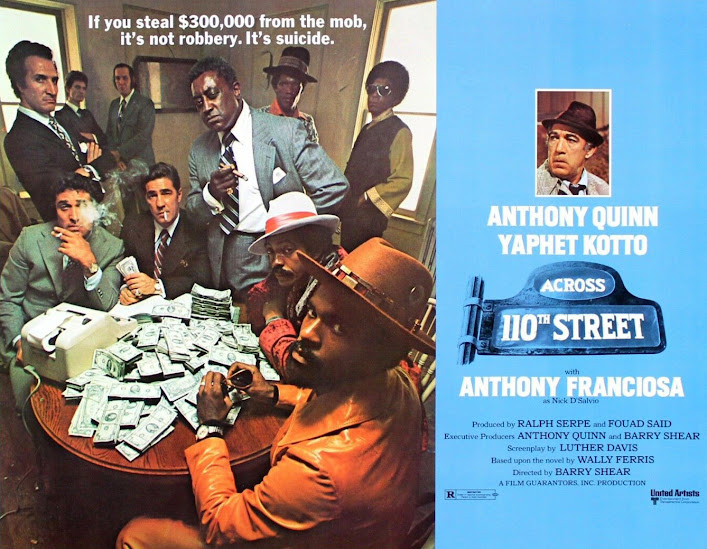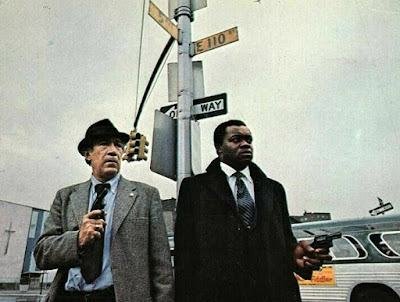A Start of Something Noir
From Noir To Eternity --- Starting With A's
Herewith I embark upon A to Z recite of film noir and notes on each I’ve watched and for most part enjoyed. Trouble is I may not be around long enough to reach Z, for A to start of C has already consumed 22,000 words, and besides that, you may all get sick of the subject well before I scratch latter half of the alphabet. Plus there’s risk of tiring over surfeit of the style, a not expected impasse, for I enjoy graze upon these, most seen before, all a joy to watch even if a mixed bag at times. There are things so relaxing, reassuring, about film noir. At late date that is our twenty-first century, they seem like costume pictures, celebration of what is gone from current culture … phone booths, upper berth on trains, snap fedoras. These we’d like back, at least I would, and noir gives them to us, at least by ninety-minute parsing. More on noir in general will drip-drab through intros to come. Titles stood alone are links to past occasion when Greenbriar visited the respective movie. I'll add to these until readership is fed up enough to call a halt. And it won’t take up every week, noir fatigue a condition better avoided.
13 West Street (1962) --- 6/8/2014
711 OCEAN DRIVE (1950) --- Edmond O’Brien was especially good as full-on go-get, dames always a temptation and signpost to disaster if not doom. Was that not noir’s way? … and yet O’Brien seemed never sated, ready the while to give up a nice, if marriage-minded, girl to hot foot after another who’s already married, allied with criminals, or plain no good. Eddie’s was confidence bound in a body just this side of a schlub’s. He sweated a lot in suits a Mitchum or Mature wore lightly. You think if a guy like this can score, why not me? 711 Ocean Drive takes the time to explain how electronics make wire services into huge business, fact that technology here is so primitive enhancing interest as in how do they make such hopeless analog work? O’Brien could play brainy types, not enough so to see a thing through right, for he was too eager a beaver to recognize stakes beyond grasp. A Mister Big like Otto Kruger need only wait out Eddie excesses, then pounce, or have others do same for him. Refreshing that Kruger escapes last reel justice … no cuffs on him … but maybe bleeding ulcers his character complains of are punishment enough. Kruger’s kind were often the final victor in noir racing, seldom shot down, often not even brought to book, at least onscreen. Was this letting us know there were certain untouchables who really were untouchable?
We understand Eddie because money, or a seeming right but invariably wrong woman, could bring anyone as easily down, but when is such temptation thrown the common man’s way? Essential message was noir life as risk seldom ending with reward, no matter how good short-term goodies were. Is even Joanne Dru worth falling off Boulder Dam for? 711 Ocean Drive is an education for those who want data on 50’s (and current) betting scourge, as is also Captive City. As for O’Brien, he peaked fortunately before pies and fries got the better of him. Did film buffs hanging about Welles’ Other Side of the Wind location ever go up and tell Eddie what a noir icon he had been, or was he too far gone by then to savor the complement? Greenbriar dealt with 711 Ocean Drive release and merchandising in June 2014. Since then, it has been released on Blu-Ray as part of one or several noir sets.
ABANDONED (1949) --- A noir can be toxic for me by content others get easily through. Case at hand: The suspense end of Abandoned where a woman with an infant child is sealed in a car filling with carbon monoxide. I’ll withstand unpleasantness in films to a point, but this swore me off Abandoned for keeps, the disc hereafter a Kino coaster. Set-up is the baby barter racket, queasy going in, which was one reason I never sought out Abandoned till now. Noir is just melodrama with nightshades on, doomed or otherwise characters to burn through according to narrative need, but small children as currency violates compact I keep with any film that is otherwise light repast, this policy applied to whatever is watched or especially re-watch. There was fence called the Code around a Classic Era I am frankly glad was there. Remove any/all barrier and movies becomes nihilistic horrors streaming nightly via various sick apps we foolishly subscribe to. Abandoned spent most years since 1949 being rare, another of Universal-International backwash to generate little interest before squirrels gathered noir nuts to feed repertory schedules. Abandoned takes mostly to streets and real-life settings, which is where current value rests. Narration portents gravity of subject, here being social contagion that might happen to yours or my “city.” I don’t know a racket that wasn’t addressed by postwar noir, except Abandoned is more a procedural, as in identify the crime, then find its perpetrator. Dark subjects were essential to studio meal plan, even where it seldom paid, unless made cheap or with a popular name, economy had where sets did not have to be built, companies realizing after the war that authenticity could be got on terms not so removed from what Italian Neorealists achieved for next to nothing. Noir in that sense became like westerns, the main obstacle being civilians poking heads into range of cameras.
THE ACCUSED (1949) --- 12/20/2017
ACE IN THE HOLE (1951) --- Souped-up precode made twenty years beyond such stuff being commonplace, but no more once Enforcement took snap out of pre-1934 garter. Who was Kirk Douglas’ Chuck Tatum but a maniacally self-conscious Ricardo Cortez? People hadn’t seen anything like Ace In The Hole for a long while, so might have been shocked, vet filmgoers less so thanks to recall of such yarns when they were freewheeling and fun. 1951 exhibitors said customers cared not for it, or were actively put off. This is not a pleasurable picture to watch, whereas precodes, never mind how caustic, always had frolicsome spirit. Since when did Warren William apologize for being ruthless? Early 30’s folk felt cheated if he wasn’t. Conscience stuff for Ace’s third act weighs hard. I wanted Chuck to get that Pulitzer Prize he literally bled for. Must my hero stumble scissor-wounded for twenty concluding minutes, a device no more welcome than Mitchum conked on the head part way into Where Danger Lives ?
Noirs are to relax and amuse, like anything I watch, so don’t let’s have cracked skulls or holes poked in bellies. Wilder’s “meaningful” shots and hard-crust dialogue are like a non-stop anvil chorus. Ace In The Hole is sort of funny until it stops being funny. Peddled by Criterion as “one of the most scathing indictments of American culture ever produced by a Hollywood filmmaker,” to which I say Ho-hum, because isn’t that what we essentially get from everything now? Length sits heavy as rocks on hapless Leo Minosa, 111 minutes for what should conclude in 80. Somewhere Wilder got his notion that a morally parched America needed his reproof and so set action in as arid a spot imaginable. Maybe it helped sell cool concessions at least to those who stayed the feature course. Me for bailing out on Kirk’s contrition, finger poised upon the fast forward but not pushing as a voice said no, because chances are you will not be sitting through this one again. More about myths surrounding Ace In The Hole from 2007 … it’s a chapter as well in Showmen, Sell It Hot!. And no, Paramount didn’t “dump” it, or misunderstand it, or screw over Wilder. Ace In The Hole just wasn't enjoyed enough by a then-public to be declared a success.
ACROSS 110th STREET (1972) --- Should definitions of noir widen to include Across 110th Street? --- because I’m for adding this must of a crime study from 1972, an ensemble of near epic dimension that surprises me for not being much better known and regarded. I’d call Across 110th Street a street-level Godfather for canvas it fills, setting and locations as gritty as seventies backdrop could yield. Muddy, grainy, as what we want and expect of the period, Across 110th Street was of sort we’d sit through at the old College Park Cinema and wonder if there was something wrong with the print or the projector. A new decade raised bars for explicit depiction of crime. The French Connection went farther than we had been accustomed to. Beside it, then-recent Bullitt punches seemed pulled. The newly wrought ratings system made extreme profanity an option, “R” a license to kill not with dispatch, but on cruelest graphic terms. At last we saw what hardened police did on everyday fields of combat, and the effect was thrilling. Classification called noir would be revamped now that movies spoke blunt as never before.
Across 110th Street might have shocked more had there not been so many similar ventures tumbling over one another in suddenly crowded charnel houses with R for Restricted hung over each, grim joke being so few venues enforced the age requirement to get in (no one at the Liberty stopped me during early ratings period before I came of age, and Ann saw The Godfather alone at the Liberty when she was eleven). Cop films were made either for this hard-tack market or what was left of “family” viewing, thus a McQ where John Wayne applied brakes to mayhem and salty talk, this against backdrop of Dirty Harry, Popeye Doyle, or Across 110th Street’s Anthony Quinn killing with abandon. Quinn co-produced Across 110th Street, so had vision to see where theatre screens were headed. His is as modern a character and performance as any veteran star gave during such upend of film decorum. Theme of the Mafia muscling into Harlem rackets gives glimpse of worst in both worlds, theme tune for Across 110th Street by Bobby Womack a Top 40 hit to give impression that the film was “blaxploitation,” confining category for a show that cast much wider a net. Here is top-notch noir I don’t hesitate to put in that category, one of the seventies’ best, and available on a nice Blu-Ray from Kino.
















7 Comments:
Agreed as to Across 110th Street, it ought to be better known. A fine example of its genre.
Do you plan to touch on the "Crime Doesn't Pay" shorts? A lot of them, maybe most, feel very noirlike.
Some are fun little cop-and-robber stories with MGM gloss, and a bit quaint with the MGM Crime Reporter introducing fake police chiefs. But many are dark and grim, still surprisingly effective in giving you a sick feeling as various victims -- desperate men falling for gangsters' pitches, decent folk who resist in vain, or innocent bystanders -- come to misery or death, not to be rescued when the law finally triumphs.
The tone is that you, the viewer, should not only despise criminals but feel personal guilt and shame for allowing these things to happen. And as a rule they're too persuasive to be easily mocked or dismissed. Always wondered how they played as part of an escapist night at the movies.
Donald, you have summed up the things I do NOT like about "Crime Doesn't Pay," namely the fact they are, for the most part, such downers, too many victims, innocent bystanders, getting the worst of it, conveying a hopelessness that anything can be done to relieve the scourge. Yes, they are not easily mocked or dismissed. This separates them, at least from me, from the abstract, essentially romanticized, world that is noir. What makes noir sustain is that with each passing year, they become more and more a stylized fantasy of how life was once lived and won't be again, against backgrounds that are intensely appealing for a lot of us. Just for instance, TCM ran THE TURNING POINT (1952) this past weekend, with all that wonderful work done at the long gone Bunker Hill section of L.A. For me at least, this amounts to a Land of Oz I could happily occupy, if such a place still stood.
I only saw Across 110th Street just once, on television with commercials and dubbed in Spanish. It was enough in the sense I have never forgotten it and I remember it vividly. I was actually impressed with the violence displayed on the screen or its consequences, yet it is a terrific film.
I find the noir genre as a whole a bit of a downer, albeit not as concentrated as the CDP shorts. I prefer my murders to be whodunit puzzles, and my fedora-wearers to smell of Damon Runyon instead of desperation. Some argue for the Michael Shayne series with Lloyd Nolan as early noir, but any resemblance ends with Shayne being a hard-up PI. He's not cynical or disillusioned. He simply knows the score and cheerfully makes the best of it.
Terrific idea for a series! Your comments on ABANDONED and babies in noirs calls to mind an evening some years back when a group of friends gathered here to watch GUN CRAZY on DVD for the first time. About four couples. Late in the picture when leading lady Peggy Cummins casually scoops up her boyfriend's tiny niece as a handy hostage, everyone gasped out loud together!
Will have to part company on ACE IN THE HOLE, one of my ten all time favorites, a movie I have watched and enjoyed MANY times. With all due respect, your Ricardo Cortez/Warren William comparison seems a little goofy. Faulting a postwar noir for not being 'frolicsome' seems, umm, a little off mark. I dig 50's era Kirk Douglas who could slide from smirky self satisfaction into sweaty self loathing in a heartbeat. Not frolicsome perhaps, but fun (well, in a grim way!) Besides how can you not love a film that casts Porter Hall as the voice of moral authority?
Great piece though, can't wait for more!
Ace in the Hole gave my wife nightmares two nights straight -- the sure sign of a great movie. Love it.
Post a Comment
<< Home